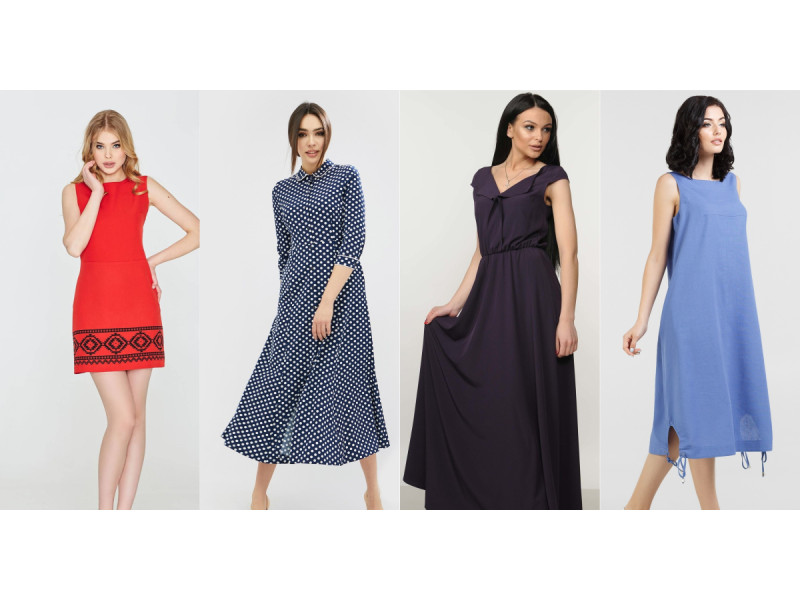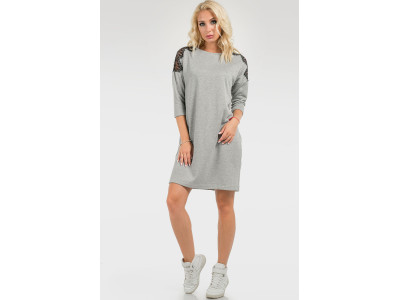A dress is the most common and, perhaps, the most spectacular item of a woman's wardrobe. Their variety allows you to choose a suitable outfit for any physique and occasion. And what exactly are the styles of dresses and how do they differ, let's find out together.
Sheath dress
A sheath dress is a symbol of comfort and elegance. It has been a staple of women's wardrobes for almost a hundred years. The peak of popularity of this style was in the thirties and sixties of the last century thanks to Jacqueline Kennedy, Audrey Hepburn and Edith Piaf. It is difficult to imagine a model that is more feminine, practical and does not look defiant at all. The peculiarity of a sheath dress is that it neatly follows the curves of the figure, without being tight or emphasizing any part of the body.
Due to its versatility, it can be worn to a formal event, a business meeting, a party, or a date.
The fabrics used to make a sheath dress can vary depending on the season and purpose. The sleeves can be long or short, ¾ or none at all. A little decoration or well-chosen jewelry and, voila: a sleeveless sheath dress becomes a cocktail dress.
A-line dress
The trapeze dress appeared in the sixties and immediately found many admirers around the world. Its style is free, simple and comfortable - narrowed in the shoulders and chest, one-piece cut with tucks, it gradually widens to the bottom. The flared skirt does not constrain movements and the dress is practically not felt on the body.
A-line dresses will suit almost all women, except perhaps those with an inverted triangle shape. Their owners should pay attention to slightly fitted models of such dresses.
Trapeze dresses are found in collections for any season. So, in the summer these dresses are made of light fabrics - silk, linen, staple, chintz. Models with bright decor and prints are often found. And winter options - knitted, woolen, etc. In addition, there is a large selection of festive dresses of this style. In this case, they are made of satin, chiffon, guipure or other expensive festive fabrics. Despite the fact that the trapeze style is absolutely classic, there are many variations of its models. Sleeves can be short, long, ¾, flashlight, with "wings" or absent altogether. The shape of the neckline is also diverse: the most popular options are round or boat, models with a turn-down collar, for example, semi-circular, are also often found. Rarer models with a V-neck, collar-clamp or stand-up collar. The decor is diverse, trapeze dresses with patch pockets are often found. Brooches on the chest or small scarves around the neck look brilliant with this dress.
Overall, the A-line dress is a unique option in which external bagginess and shapelessness are combined with femininity and elegance. This model is perfect for office style or attending formal events.
A-line dress ("fish", "mermaid")
This style is most often used for evening dresses. Their floor-length silhouette is best showcased by the so-called mermaid tail. However, there are also many midi-length casual dresses with this cut.
Godet is the name given to the widening of a fitted skirt at the bottom with the help of sewn-in wedges or a wide frill. In this case, the top of the dress can be strict or even slightly rustic. It doesn’t matter, because all attention will be focused on the legs.
A-line dresses first became popular in the era of Brigitte Bardot and still do not give up their fashionable positions.
Shirt dress
A shirt dress can be fitted or loose and fasten in front with buttons (as an option - with snaps). It remotely resembles a men's shirt, while retaining only the principle of the cut and, as a rule, the collar. The sleeves are attached by sewing, patch pockets on the chest are often found. By the way, one of the subspecies of the shirt dress is the safari model. Such dresses are democratic and relaxed: on the one hand, strict and masculine lines are combined with a primitive conservative cut, and on the other - it is still a dress: feminine and elegant. A shirt dress will be appropriate in everyday life, when traveling, in nature, and sometimes even at work.
Most often, such dresses are sewn from natural fabrics: all kinds of variations of denim, linen, corduroy, staple and others. The most popular are all shades of blue, sand tones and black. Often, shirt dresses are decorated with fringe, embroidery or a belt. They look good both on their own and with leggings, jeans or tight stockings and, depending on the occasion, go well with high-heeled shoes, sneakers and ballet flats.
Mallet dress
An unfamiliar word means the name of a dress that has been well-known to us for several seasons now. This is a multi-level dress, the hem of which is longer at the back (sometimes very much) than at the front. This style is still at the peak of popularity. The decor and style of the model can be varied - from evening with a train - to everyday knitwear.
The silhouettes and cut are different: fitted, flared from the waist, trapezoidal, etc. The length can also be varied depending on the boldness and purpose, and its transition can be either gradual or torn.
There is an interesting psychological aspect to wearing such a dress: on the one hand, you significantly expose your legs, overcoming shyness, and on the other hand, you feel comfortable and secure, looking modest.
Bustier dress
Even the name of the dress is tempting in itself. But, having a common name, the number of interpretations can be different.
This style is characterized by an open neckline, shoulders and neck. It is advisable to do without straps at all, but thin ones are still permissible. Due to the strong openness, such dresses are usually chosen in the warm season or covered with a bolero.
There are many silhouette options. These are mini, floor-length, flared, fitted, made of light fabric, and made of expensive materials. The common feature is one: it is very sexy.
A bustier dress will suit almost any body type, the main thing is to choose the right model. For example, a mid-length style with a high waist can hide flaws in the abdomen or hips, and a wide, loose-fitting skirt can balance out broad shoulders.
Particular attention should be paid to the choice of underwear: if you are not ready to give up the bra altogether, it should be the "Angelica" shape, naturally without straps.
Tuxedo dress
A notable feature of this style is the large number of ruffles. Literally, from head to toe. Or rather, starting from the chest. A smock dress, as a rule, either with a high waist, or without a pronounced one as such. The length is above the knee, can be with an American armhole, on straps or a bustier. Thanks to the free cut, it successfully hides figure flaws and is suitable for pregnant girls. This model is quite elegant - it is often chosen for a cocktail dress. And in everyday life it can be a beach sundress.
Dress with a tutu
The name of this dress (or rather, skirt) speaks for itself. Ballet-themed associations have shown the world many stylish models.
A decade ago, tutu skirts, apart from ballet, were used only at thematic photo shoots. There were a couple of attempts to popularize this element of clothing: in 1954, Marilyn Monroe, who starred for the cover in a tutu, and in 1984, Madonna in the video Like a Virgin. But they migrated to everyday wardrobe, apparently, after the star of the TV series “Sex and the City” Sarah Jessica Parker, made such a skirt trendy in combination with familiar things.
The bodice of such a dress can be different – from a deliberately eclectic sports top of a loose cut, to a delicate lace bustier top decorated with rhinestones. It all depends on your sense of well-being and the purpose of this wardrobe item. But the skirt will always resemble a ballet tutu. True, the length, volume, color and material can be chosen.
Such a skirt always has several layers at its base: from three to 12. Organza, tulle, satin, chiffon and tulle are the most popular materials for this dress. In the last few seasons, black, white, powder, coral red and all sorts of blue shades have been the most popular. Although, as they say, color is a matter of taste.
You can combine a tutu dress with both a stiletto heel and sneakers. Thanks to today's fashion for that.
Tunic
Tunic - originally a men's garment. It was a long hooded robe with wide sleeves and a wide belt. In the 14th-15th centuries in Europe, this wardrobe item began its transformation: the silhouette became narrower, the tunic became shorter, and women's models began to appear.
Today, a tunic is a practical, roomy dress (or blouse) that can be worn on its own or paired with jeans or leggings.
Bag dress
A shapeless, baggy dress that appeared in the 1920s. This relaxed silhouette allows you to hide figure flaws and can be worn in any weather. It is a great option for casual style, and sometimes even for a democratic business style.
The cut of the baggy dress is absolutely simple and trivial: there are no tucks, bust lines or waistlines. The length varies from mini to floor-length models. In today's fashion, the more baggy these dresses are, the better. Combining bagginess with the oversized trend, sometimes fantastic hoodies are obtained. Combine them with sneakers, wedge shoes or rough heels. The variety of fabrics is huge: depending on whether it is satin, chintz or wool, completely different products are obtained.
Baby doll dress
A touching, and sometimes even infantile dress. Childishly direct, flirtatious and doll-like. Such models look most advantageous on thin, miniature girls.
They emphasize the figure and slimness of the legs, but ladies over 35 or with a full build should not experiment with this style.
Distinctive features of baby doll dresses: minimalist length, full skirt, often multi-layering and / or high waist. The neckline is diverse: from low and closed to the deepest and most open. Sleeves are usually absent or short, although there are also ¾ and even long ones. Often baby doll dresses are additionally decorated with the most feminine elements: lace, rhinestones, flounces.
The fabrics used are light and those that drape beautifully: silk, guipure, chiffon, and others.
A-line dress
The A-line dress is a striking style that harks back to the 1960s. It features a fitted bodice and a full, flared mid-length skirt. It was created by Cristóbal Balenciaga and Christian Dior, who popularized the silhouette on the catwalks in the 1950s.
The skirt of the A-line dress is soft, flowing or stiff due to the petticoat. The sleeve is often short, but options are possible. The neckline is also diverse: stand-up collar, turn-down collar, deep neckline.
Such midi-length dresses are great helpers in creating a romantic look, and the maximum length can be chosen for a wedding or evening dress.
Popular colors are pastel and romantic or bright and graphic in a retro style, such as large stripes or polka dots.
Sports dresses and polo model
In the traditional classification of dresses, this item includes short dresses with a recognizable polo collar. But we decided to include all sports models here. Firstly, they have a similar purpose, and secondly, today there are more and more sports models, because fashion gravitates towards comfort and this fact cannot be ignored.
Yes, the common feature of all sports dresses is natural or membrane materials, short length and a comfortable simple cut that does not constrain movements. The classic polo style is the dresses that we can see on tennis players: a tight-fitting top, a turn-down collar, a short, not fluffy, loose skirt, short sleeves and a pocket on the chest. It is convenient to wear such a dress not only on the court, of course. Walks, shopping, playgrounds, going to training, relaxing at home, etc.
Thanks to emancipation, these dresses can be worn from about the 70s of the last century. It was then that women had the opportunity to significantly bare their legs. In addition to the polo style, other sports dresses can also boast of practicality and versatility. Most often they are made of knitwear, knee-length or mini, the cut can be either slightly fitted or straight, can have a hood, and they are usually fastened with a zipper.
Balloon dress
Bubble dress – a model with a gathered hem. This technique creates the effect of a puffed edge without a clear line. Lightness is achieved by rolling up a strip of fabric and sewing it to the lining 5-10 cm above the hem from the inside out. The higher the seam line, the more “puffed up” the skirt. The shape of the skirt is necessarily widened to the bottom, but the pomp can start both from the waist and below. The bodice is usually minimalist, because all attention is focused on the skirt. Often such models are made from a combination of two fabrics – for the bodice and for the skirt. The fabrics are chosen in a variety of ways, but the denser the material, the more magnificent the skirt will be. Such a model can hide full hips and emphasize the waist.
Dress with a smell
Its designer, Diane von Furstenberg, dreamed of creating something light and feminine. We have to say that she succeeded. In 1972, the designer became world famous, and the dress became an American bestseller and a true cult brand.
In a dress of this style, the bodice is divided into two parts that wrap one on top of the other, forming a seductive V-shaped neckline.
The original classic length is considered to be knee-length, but today this does not matter. Often, ties are used at the waist to fix the halves of the dress, slightly resembling a dressing gown. If this similarity confuses you, choose dresses made of expensive fabrics, and if you are looking for a simple everyday option, then opt for knitwear or light cotton fabrics.
The win-win features of such dresses are: visual narrowing of the shoulders, emphasized waist, lengthening of the silhouette, emphasis on the bust. It is probably difficult to find a girl who would not like a dress with a smell: for fragile young ladies it will only help to emphasize elegance, and for full ones - to hide flaws with draperies and an emphasis on the waist. In general, a real must-have.
Dress with American armhole
American is called a diagonal armhole, which goes from the armpits to the neck. There are three versions of this style. In the first, the dress is tightly closed in front and back, the stand-up collar completely encircles the neck. In the second, the chest is also closed, the back is bare, and the neck can be either buttoned or tied. The third version is with a V-shaped neckline in the form of a so-called loop, which is tied around the neck, opening the back.
It was the latter version, a snow-white dress with a light skirt that fluttered in the air from a ventilation grille, that was worn by Marilyn Monroe in a world-famous scene. It was after this film that dresses with an American armhole became seriously fashionable. However, back then, in the 50s, they were considered exclusively evening models.
Today, dresses with an American armhole - long and short - have perfectly "adapted" to everyday looks.
Such a dress should be chosen with care by sporty ladies with shoulders wider than hips and a subtle waist. Dresses with an American armhole are not suitable for women with very sloping shoulders or a short neck. There are no contraindications for all others.
Bat-sleeve dress
This style is the heir to the Japanese kimono, which got its name for its resemblance to the webbed wings of bats. A feature of the cut of such dresses is the sleeve, which resembles the flapping of a wing. This dress gained real popularity in the 80s of the last century. It involves a wide voluminous top and a tight, often short, bottom. The most spectacular options are made of flowing fabrics with draperies and knitwear. The shape of the neckline can vary. Most often it is a boat or a rounded neckline, sometimes there are collars-clamps. In the most extravagant evening models, the back can be bare to the waist.
One of the modern highlights of the batwing dress is the slit along the entire length of the long sleeve - from shoulder to wrist, which draws attention to the hands and distracts from other parts of the body.
This dress looks great on a girl with an inverted triangle figure. It can successfully hide broad shoulders and full arms, while emphasizing slender hips. Short fashionistas in such a dress will look even shorter, so they should only wear very high heels with a batwing dress.
Shemiz dress (shemez, shemizye)
The name of this dress has not really taken root, unlike the style itself. It dates back to the Middle Ages. True, then it was an undershirt, not a dress. But thanks to the enterprising Cristobal Balenciaga, already familiar to us, in the late 50s, the shirt turned into a dress and took on the anger and indignation of the representatives of high society. Despite this, the chemise dress still took root in the wardrobes of fashionistas around the world.
The chemise dress is characterized by a well-thought-out cut with dropped shoulders, a drawstring waist, and knee-length. It has gained popularity due to its comfort and versatility.





















Write a comment